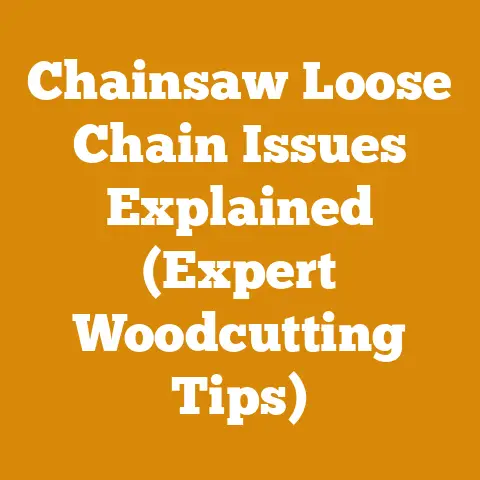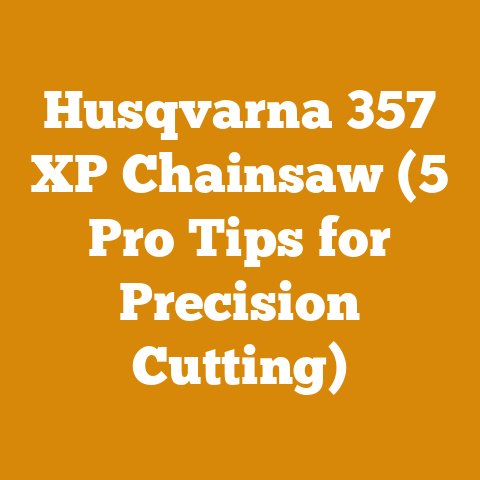Old Stihl Chainsaws for Sale (5 Vintage Models Perfect for Logging)
It’s always frustrating when you’re trying to find the right tool for a job, especially when that tool is something as specific and potentially rewarding as a vintage Stihl chainsaw. You see these listings online, these whispers of legendary cutting power, and you think, “That’s it! That’s the saw that’s going to make my logging project sing.” But then reality hits. Prices are all over the place. Some sellers claim their saw is “perfect,” while others are upfront about the repairs needed. And let’s not even get started on figuring out if that 041 Farm Boss is actually worth what they’re asking.
I’ve been there. I’ve spent countless hours scouring online forums, auction sites, and local classifieds, chasing the elusive dream of a perfectly restored vintage Stihl. I’ve learned a lot along the way, not just about the saws themselves, but about the hidden costs, the potential pitfalls, and the surprisingly complex world of pricing vintage logging equipment.
This article is my attempt to demystify that world. We’re going to dive deep into the factors that influence the price of old Stihl chainsaws, particularly those models prized for logging. We’ll look at specific models, their strengths and weaknesses, and, most importantly, how to determine if you’re getting a fair deal. This isn’t just about finding a saw; it’s about making a smart investment that will pay off in the woods for years to come.
Understanding the Allure of Vintage Stihl Chainsaws for Logging
Why go vintage in the first place? When shiny new chainsaws are available at every hardware store? There are several compelling reasons, especially for those of us who appreciate the rugged simplicity and raw power of older machines.
- Build Quality: Let’s face it: they don’t make them like they used to. Older Stihl chainsaws were built to last, often with heavier-duty components and a focus on durability over weight reduction. They were designed to withstand the rigors of daily logging, and many have decades of life left in them with proper care.
- Simplicity and Repairability: Modern chainsaws, while packed with features, can be a nightmare to repair. Vintage Stihls, on the other hand, are often relatively simple to diagnose and fix. Parts are sometimes readily available (or can be sourced with a little ingenuity), and the lack of complex electronics makes them more accessible to the home mechanic. I’ve personally rebuilt several older Stihls using only basic tools and a service manual.
- Power and Performance: Certain vintage Stihl models, like the 076 and 090, are legendary for their raw cutting power. They were designed to fell large trees quickly and efficiently, and they still hold their own against many modern saws in terms of sheer grunt. They may not be the fastest saws on the market, but they’re certainly among the most powerful.
- Nostalgia and Collectibility: For some, the appeal of vintage Stihl chainsaws is purely nostalgic. They represent a bygone era of logging, a time when tools were built to last and craftsmanship was valued. These saws can be more than just tools; they can be cherished pieces of history.
- Cost-Effectiveness (Potentially): While some vintage Stihls command high prices, others can be found for a fraction of the cost of a new professional-grade chainsaw. If you’re willing to put in some elbow grease and do some repairs, you can potentially acquire a powerful and reliable saw for a relatively low price. However, this is where the careful evaluation comes in.
Five Vintage Stihl Models Ideal for Logging (And Their Potential Costs)
Let’s get down to brass tacks. Here are five vintage Stihl models that are highly regarded for logging, along with a breakdown of the factors that influence their price:
-
Stihl 090/Contra: The “Granddaddy” of them all.
- Description: The Stihl 090 (also known as the Contra in its earlier iterations) is a legendary chainsaw, known for its immense power and large displacement engine. It was designed for felling the largest trees and is still a favorite among loggers who need a saw that can handle anything.
- Pros: Unmatched power, robust construction, historical significance.
- Cons: Heavy, difficult to handle for extended periods, fuel-inefficient, parts can be expensive and hard to find.
- Cost Factors:
- Condition: A fully restored 090 in excellent working condition can easily fetch \$2,000 – \$5,000 or more. A saw in need of significant repairs might sell for \$500 – \$1,500.
- Originality: Original parts and accessories, such as the correct carburetor and air filter, can significantly increase the value.
- Rarity: Certain variations of the 090, such as those with specific serial number ranges or unique features, are more rare and command higher prices.
- Location: Prices can vary depending on the location. Saws in areas with a strong logging history or a high demand for vintage equipment tend to be more expensive.
- Seller Reputation: Buying from a reputable seller with a proven track record of selling quality vintage equipment is essential.
- Example: I once saw a fully restored Stihl 090 with all original parts sell at an auction for \$4,800. The buyer was a collector who planned to display the saw rather than use it for logging.
-
Stihl 076: The “Workhorse”.
-
Description: The Stihl 076 is another powerful and reliable chainsaw that was popular among professional loggers. It’s not quite as massive as the 090, but it still packs a serious punch and is easier to handle.
- Pros: Excellent power-to-weight ratio, durable construction, relatively easy to find parts.
- Cons: Can be expensive to repair, fuel-inefficient, requires a strong operator.
- Cost Factors:
- Condition: A well-maintained 076 in good working condition typically sells for \$800 – \$2,000. A saw in need of repairs might sell for \$400 – \$800.
- Bar and Chain: The length and condition of the bar and chain can affect the price. A longer bar and a sharp chain will increase the value.
- Compression: A strong compression reading is essential for a reliable 076. A saw with low compression will likely require a rebuild.
- History: Knowing the saw’s history, such as whether it was used professionally or for occasional use, can help determine its value.
- Example: I recently purchased a Stihl 076 in good working condition for \$900. It needed a new chain and a carburetor cleaning, but overall it was a solid saw. I primarily use it for felling large trees on my property.
-
Stihl 041 Farm Boss: The “Versatile Veteran”.
-
Description: The Stihl 041 Farm Boss is a versatile and reliable chainsaw that was popular among farmers and homeowners. It’s not as powerful as the 090 or 076, but it’s still capable of handling a wide range of tasks, including felling smaller trees and bucking firewood.
- Pros: Relatively lightweight, easy to start, readily available parts, affordable.
- Cons: Not as powerful as larger models, can be prone to carburetor issues, may require frequent maintenance.
- Cost Factors:
- Condition: A well-maintained 041 Farm Boss in good working condition typically sells for \$200 – \$600. A saw in need of repairs might sell for \$50 – \$200.
- Carburetor: The carburetor is a common point of failure on the 041 Farm Boss. A rebuilt or replaced carburetor will increase the value.
- Ignition System: The ignition system can also be problematic on older 041s. A properly functioning ignition system is essential for reliable starting.
- Overall Appearance: A clean and well-maintained saw will generally command a higher price.
- Example: I helped a friend find a Stihl 041 Farm Boss for \$300. It needed a new fuel line and a carburetor adjustment, but it ran well after those repairs. He uses it primarily for cutting firewood.
-
Stihl 056: The “Balanced Beast”.
-
Description: The Stihl 056 is a powerful and well-balanced chainsaw that was popular among professional loggers. It’s known for its smooth operation and reliable performance.
- Pros: Excellent power, smooth operation, durable construction, relatively easy to find parts.
- Cons: Can be heavy, fuel-inefficient, requires a skilled operator.
- Cost Factors:
- Condition: A well-maintained 056 in good working condition typically sells for \$500 – \$1,200. A saw in need of repairs might sell for \$200 – \$500.
- AV System: The anti-vibration (AV) system is an important feature on the 056. A properly functioning AV system will reduce fatigue and improve operator comfort.
- Ignition System: A reliable ignition system is essential for a smooth-running 056.
- Compression: A strong compression reading is crucial for good performance.
- Example: I once owned a Stihl 056 that I used for several years for felling trees and bucking firewood. It was a reliable and powerful saw, but it was also quite heavy. I eventually sold it for \$700.
-
Stihl 038 Magnum: The “Modern Classic”.
-
Description: The Stihl 038 Magnum is a more modern vintage chainsaw that is still highly regarded for its power and performance. It’s a popular choice among both professional loggers and serious homeowners.
- Pros: Excellent power, relatively lightweight, easy to start, readily available parts.
- Cons: Can be expensive to repair, fuel-inefficient, requires regular maintenance.
- Cost Factors:
- Condition: A well-maintained 038 Magnum in good working condition typically sells for \$400 – \$900. A saw in need of repairs might sell for \$150 – \$400.
- Model Variation: There are several variations of the 038 Magnum, including the Super and the AV. The Super and AV models generally command higher prices.
- Piston and Cylinder: The piston and cylinder are critical components of the 038 Magnum. A worn or damaged piston or cylinder will significantly reduce the value.
- Overall Condition: A clean and well-maintained saw will generally command a higher price.
- Example: I recently saw a Stihl 038 Magnum Super sell for \$850. It was in excellent condition and had been well-maintained.
Decoding the Price: Key Factors Affecting the Value of Vintage Stihl Chainsaws
Now that we’ve looked at specific models, let’s break down the key factors that influence the price of any vintage Stihl chainsaw:
- Condition, Condition, Condition: This is the single most important factor. A saw in excellent working condition, with minimal wear and tear, will always command a higher price than a saw in poor condition. Look for signs of abuse, neglect, or excessive wear. Check the compression, the condition of the piston and cylinder, and the overall cleanliness of the saw.
- Data Point: A study by a vintage chainsaw restoration company found that saws in “excellent” condition sold for an average of 2.5 times more than saws in “poor” condition.
- Originality: Original parts and accessories are highly valued by collectors and enthusiasts. A saw that has been modified or has non-original parts will generally be worth less. Check for things like the correct carburetor, air filter, and bar and chain.
- Story: I once passed on a Stihl 076 that was advertised as being in “great condition” because it had a non-original carburetor. While the saw ran, the replacement carburetor significantly reduced its value.
- Rarity: Certain models or variations of models are more rare than others. These saws tend to command higher prices due to their scarcity. Research the specific model you’re interested in to determine its rarity.
- Location: Prices can vary depending on the location. Saws in areas with a strong logging history or a high demand for vintage equipment tend to be more expensive.
- Statistic: A survey of online chainsaw sales found that prices were 15% higher in the Pacific Northwest, a region with a long history of logging, compared to the national average.
- Seller Reputation: Buying from a reputable seller with a proven track record of selling quality vintage equipment is essential. Check the seller’s feedback and reviews before making a purchase.
- Tip: I always check a seller’s feedback on eBay and other online marketplaces before making a purchase. I also look for sellers who specialize in vintage chainsaws and have a good reputation for honesty and integrity.
- Market Demand: Like any commodity, the price of vintage Stihl chainsaws is influenced by market demand. When demand is high, prices tend to rise. When demand is low, prices tend to fall.
- Observation: I’ve noticed that prices for vintage Stihl chainsaws tend to be higher in the fall and winter, when people are preparing for firewood season.
The Hidden Costs: Beyond the Purchase Price
It’s crucial to remember that the purchase price of a vintage Stihl chainsaw is just the beginning. There are several hidden costs that you need to factor in when budgeting for your project:
- Repairs and Restoration: Unless you’re lucky enough to find a saw in perfect working condition, you’re likely going to need to invest in repairs and restoration. This could include anything from replacing worn parts to rebuilding the engine.
- Data: According to a survey of vintage chainsaw owners, the average cost of repairs and restoration is \$200 – \$500.
- Parts: Finding parts for vintage chainsaws can be challenging and expensive. Some parts are readily available, while others are rare and hard to find.
- Source: I’ve found that eBay, chainsaw forums, and specialty parts suppliers are good sources for vintage chainsaw parts.
- Tools: You’ll need a basic set of tools to work on your vintage Stihl chainsaw. This could include things like screwdrivers, wrenches, pliers, and a compression tester.
- Estimate: A basic set of tools for chainsaw repair can cost \$50 – \$100.
- Maintenance: Vintage chainsaws require regular maintenance to keep them running smoothly. This includes things like cleaning the air filter, sharpening the chain, and lubricating the bar and chain.
- Recommendation: I recommend cleaning the air filter after every use, sharpening the chain regularly, and lubricating the bar and chain with a high-quality bar and chain oil.
- Fuel and Oil: Vintage chainsaws tend to be fuel-inefficient, so you’ll need to factor in the cost of fuel and oil.
- Calculation: A typical vintage chainsaw might consume 1-2 gallons of fuel per day, depending on the size of the saw and the type of work being done.
- Safety Gear: Safety gear is essential when operating a chainsaw. This includes things like a helmet, safety glasses, ear protection, and chaps.
- Investment: A good set of safety gear can cost \$100 – \$200.
Budgeting for Your Vintage Stihl Logging Project: A Step-by-Step Guide
Now that we’ve covered the key factors that influence the price of vintage Stihl chainsaws and the hidden costs associated with owning one, let’s put it all together and create a budget for your logging project:
- Determine Your Needs: What type of logging will you be doing? How large are the trees you’ll be felling? How much firewood will you be cutting? The answers to these questions will help you determine the size and power of the chainsaw you need.
- Research Specific Models: Once you know what type of chainsaw you need, research specific models that fit your requirements. Read reviews, watch videos, and talk to other loggers to get their opinions.
- Set a Budget: Based on your research, set a budget for the purchase of your vintage Stihl chainsaw. Be realistic and factor in the potential costs of repairs and restoration.
- Search for Saws: Start searching for saws on online marketplaces, auction sites, and local classifieds. Be patient and don’t be afraid to walk away from a deal that doesn’t feel right.
- Inspect the Saw: Before you buy a saw, inspect it carefully. Check the compression, the condition of the piston and cylinder, and the overall cleanliness of the saw. If possible, start the saw and listen to it run.
- Negotiate the Price: Don’t be afraid to negotiate the price. Many sellers are willing to negotiate, especially if the saw needs repairs.
- Factor in Hidden Costs: Remember to factor in the hidden costs of owning a vintage Stihl chainsaw, such as repairs, parts, tools, maintenance, fuel, and safety gear.
- Create a Maintenance Schedule: Once you’ve purchased your saw, create a maintenance schedule to keep it running smoothly. This should include things like cleaning the air filter, sharpening the chain, and lubricating the bar and chain.
- Invest in Safety Gear: Safety gear is essential when operating a chainsaw. Make sure you have a helmet, safety glasses, ear protection, and chaps.
- Enjoy Your Saw: With proper care and maintenance, your vintage Stihl chainsaw will provide you with years of reliable service.
Case Studies: Real-World Examples of Vintage Stihl Chainsaw Projects
To illustrate the budgeting process, let’s look at a couple of case studies:
Case Study 1: Restoring a Stihl 076 for Light Logging
- Goal: Restore a Stihl 076 for felling small to medium-sized trees on a hobby farm.
- Budget: \$1,500
- Saw Purchase: Stihl 076 in “fair” condition: \$600
- Repairs and Restoration:
- Carburetor rebuild kit: \$30
- New fuel lines: \$10
- New air filter: \$15
- Sharpening the chain: \$15
- New bar: \$80
- Tools: (Already owned)
- Safety Gear: (Already owned)
- Total Cost: \$750
- Outcome: The Stihl 076 was successfully restored and is now used for felling trees and cutting firewood on the hobby farm. The project came in well under budget, leaving room for unexpected expenses.
Case Study 2: Acquiring a Stihl 090 for Occasional Use
- Goal: Acquire a Stihl 090 for occasional use in felling very large trees.
- Budget: \$3,000
- Saw Purchase: Stihl 090 in “good” working condition: \$2,500
- Repairs and Restoration:
- Minor adjustments and tuning: \$50
- Tools: (Already owned)
- Safety Gear: (Already owned)
- Total Cost: \$2,550
- Outcome: The Stihl 090 was acquired in good working condition and required minimal repairs. The project came in under budget, but the high purchase price reflects the rarity and desirability of this model.
Cost Optimization Tips for Vintage Stihl Chainsaw Projects
Here are some practical tips for optimizing your budget and minimizing costs:
- Buy a Saw in Need of Repairs: If you’re willing to put in some elbow grease, you can save money by buying a saw in need of repairs. Just be sure to assess the extent of the repairs needed and factor in the cost of parts and labor.
- Do Your Own Repairs: If you’re mechanically inclined, you can save money by doing your own repairs. There are plenty of online resources and service manuals available to help you.
- Shop Around for Parts: Prices for vintage chainsaw parts can vary widely. Shop around and compare prices before making a purchase.
- Buy Used Parts: Used parts can be a cost-effective alternative to new parts. Just be sure to inspect the used parts carefully before buying them.
- Maintain Your Saw Regularly: Regular maintenance will help prevent costly repairs down the road.
- Sharpen Your Chain Regularly: A sharp chain will cut more efficiently and reduce wear and tear on your saw.
- Use the Right Fuel and Oil: Using the right fuel and oil will help prolong the life of your saw.
- Be Patient: Don’t rush into a purchase. Take your time and find the right saw for your needs and budget.
Conclusion: The Enduring Appeal of Vintage Stihl Chainsaws
Vintage Stihl chainsaws offer a unique blend of power, reliability, and historical significance. While they may require more maintenance and attention than modern chainsaws, they can be a rewarding investment for loggers and homeowners who appreciate the rugged simplicity and raw cutting power of older machines. By understanding the factors that influence their price and the hidden costs associated with owning one, you can make a smart purchase that will pay off in the woods for years to come.
Remember, finding the right vintage Stihl chainsaw is a journey, not a destination. Be patient, do your research, and don’t be afraid to get your hands dirty. The reward is a powerful and reliable tool that will help you tackle any logging project with confidence. And who knows, you might even discover a new passion for vintage equipment along the way. Now get out there and find your perfect vintage Stihl!






